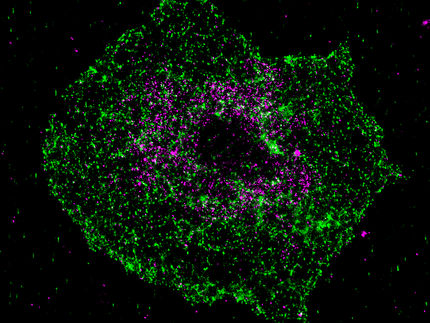Two strands are better than one
LMU medical researchers have shown that the administration of specific micro-RNAs can retard the development of atherosclerosis
atherosclerosis is a serious condition in which fatty deposits build up in the inner layer of the major arteries, provoking chronic inflammatory reactions that lead to a progressive obstruction of the vessels. This may ultimately cut off blood-flow and lead to a heart attack or a stroke.
Atherosclerosis develops primarily at sites in the arterial vasculature, at which the endothelial cells that form the inner lining of the all blood vessels are particularly susceptible to damage. “Where blood-flow is perturbed and other risk factors are present, such as hyperlipidemia with abnormally high levels of cholesterol, the cells of the endothelium mount a stress reaction, which can result in programmed cell death but also in increased proliferation of endothelial cells,” explains LMU’s Professor Christian Weber, Director of the Institute for Cardiovascular Prevention at the LMU Medical Center. The significance of this increased cell turnover for the regeneration of the endothelium and the development of atherosclerosis has, however, remained unclear.
A research team led by Weber and Professor Andreas Schoberhas now elucidated the role of two microRNAs called miR-126-3p and miR-126-5p in the process, and their findings are reported in the latest issue of “Nature Medicine”.
MicroRNAs are short strands of the eponymous nucleic acid – which is structurally related to the DNA in which the cell’s hereditary information is stored – and they play important roles in the regulation of gene activity. miR-126-5p and miR-126-3p are complementary sister strands that are derived from the same precursor hairpin RNA. “We have now shown, for the first time, that the repair of the endothelium after injury, and the regenerative proliferation of endothelial cells, is induced by miR-126-5p, which specifically inhibits production of the protein Dlk1 (Delta-like 1),” says Andreas Schober. In the absence of miR-126-5p, deposits also accumulate at sites in the vascular system where potentially proliferative endothelial cells are normally held in reserve to compensate for any damage that may occur. In a mouse model system, the researchers then demonstrated that administration of miR-126-5p was capable of preventing the development of athersclerotic lesions. “As soon as the levels of miR-126-5p are increased, the proliferative reserve of endothelial cells is restored, which protects the animals against atherosclerosis,” says Schober.
Delivery by nanoparticles
The results of the study are highly relevant for future approaches to the treatment of atherosclerosis. Both synthetic inhibitors and functional mimics of micro-RNAs are available, which can be administered by injection. “Our data suggest that the therapeutic application of miR-126-5p mimics holds promise for the treatment of atherosclerosis patients,” says Christian Weber. In their studies in mouse, he and his team have already tried out a new mode of administering these agents, in which a nanoparticle-based packaging system is used to deliver miR-126-5p to the affected tissue.
“In view of the protective effects of miR-126-3p, it might even be worthwhile to use a combination of the two strands,” Weber adds, and he is currently engaged in testing this strategy. The therapeutic procedure already devised is the subject of a patent application, and its further development is underway at the German Center for Cardiovascular Research, in collaboration with interested biotechnology firms.
Original publication
Other news from the department science
These products might interest you

Eclipse by Wyatt Technology
FFF-MALS system for separation and characterization of macromolecules and nanoparticles
The latest and most innovative FFF system designed for highest usability, robustness and data quality

DynaPro Plate Reader III by Wyatt Technology
Screening of biopharmaceuticals and proteins with high-throughput dynamic light scattering (DLS)
Efficiently characterize your sample quality and stability from lead discovery to quality control

Get the life science industry in your inbox
By submitting this form you agree that LUMITOS AG will send you the newsletter(s) selected above by email. Your data will not be passed on to third parties. Your data will be stored and processed in accordance with our data protection regulations. LUMITOS may contact you by email for the purpose of advertising or market and opinion surveys. You can revoke your consent at any time without giving reasons to LUMITOS AG, Ernst-Augustin-Str. 2, 12489 Berlin, Germany or by e-mail at revoke@lumitos.com with effect for the future. In addition, each email contains a link to unsubscribe from the corresponding newsletter.
Most read news
More news from our other portals
Last viewed contents
Tracking Down the Causes of Alzheimer’s
Thomas_J._Bouchard_Jr.
Hepatitis_B_virus
Kidney_transplantation
Edward_Yazbak
Doreen_Kimura

Scaling to new heights with gecko-inspired adhesive



















































